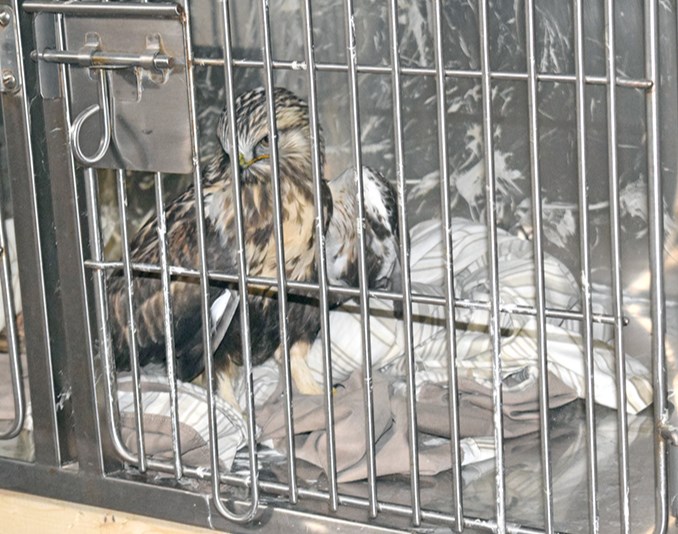CANORA - “To restore the injured or sick animal to health and then release it back to the wild.”
This is how Mary Huebert of Canora describes the focus of her recently opened Majestic Raptor Rehab birds of prey sanctuary.
Huebert and her volunteer helpers, daughter Nicole Debiasi and Marilyn Schigol, a retired nurse, received their first raptor, a round-legged hawk, on Nov. 21.
“This juvenile bird, about a year old, came from a farm in the Yorkton area,” said Huebert. “It wasn’t eating or drinking, and it couldn’t fly. We dewormed it and gave it some medication to get the bugs off. It’s coming along, eating pretty well now.”
Huebert said they’re feeding it mice, which is what it would usually be eating out in the wild.
“Birds like this one, when they first come in underweight and undernourished, we give them a critical care carnivore feeding formula, which contains nutrients to help build up the bird.”
The Huebert facility includes 42 critical care cages, which house the sick or injured birds when they first arrive. When the health of the bird has sufficiently improved, it goes into a limited flying enclosure. Eventually, the raptors are transferred to the unlimited flight pens to build up their strength for when they are released back into the wild. The pen for eagles is the largest at the facility: 100 feet long, 16 feet high, and 20 feet wide.
Huebert said that Majestic Raptor Rehab received final approval on Nov. 15, culminating a process that she had started in 2019, and then had to wait through numerous delays thanks to COVID-19.
“We have five pages of regulations we have to follow.”
They now have a Government of Saskatchewan Fish, Wildlife & Lands Branch wildlife rehabilitation license, which required approval from the RM of Good Lake, and a letter from a veterinarian who agrees to work with them. Huebert said they appreciate the support they have received from Dr. Richard Krauss of Preeceville.
“We had to take a course and write an international wildlife exam and then a provincial exam in Regina,” said Huebert.
Their facilities were all built from scratch and according to specifications from the ministry. The enclosures were constructed from treated lumber and a special type of wire. Huebert said the actual building process took about four-and-a-half months.
After all that, the final inspection brought pretty much the same thought to everyone’s mind, “Are we going to get it?” shared Huebert. “The inspectors came out and had all their sheets of paper with check boxes and measuring tapes. They literally measured everything.”
Now that the facility has been approved, they are in touch with the Wildlife Rescue Society of Saskatchewan to receive notification of any raptors, birds that hunt, in need of rehabilitation.
Huebert estimates there are approximately 25 species of raptors in Saskatchewan, including hawks, eagles, owls and falcons.
Regulations require that the care of the birds is always the top priority at the facility. They must not be posed in any way for photographs. Stress on birds is to be kept to a minimum. Huebert said one of the most difficult rules to follow is that they have to be quiet around the birds. Visits to the birds by members of the public are prohibited.
“When the raptors first come here we have them in a dark, quiet box for a while,” said Huebert. “It’s to calm them down, so you don’t end up making things worse by stressing them even more than they already are.”
Huebert and her volunteer helpers are pursuing further education in their work, taking a variety of online courses through the internationally respected University of Minnesota Raptor Centre, including: physical examination, bandaging, diet and nutrition, and the first 24 hours (after the birds arrive at a rehab facility).
Huebert said she first fell in love with rehabilitating raptors when she ran a similar facility with her daughter Shawna when she was in high school.
“I love animals,” she said. “I get a real sense of fulfilment from doing this, to nurse the bird back to health and then see it released back to the wild. Of course, the other side of it is very hard if you bring in an injured or sick animal and it doesn’t survive.”
Don't count on social media to deliver your local news to you. Keep your news a touch away by bookmarking Canora Courier's homepage at this link.
Bookmark SASKTODAY.ca, Saskatchewan's home page, at this link.




